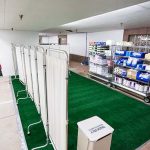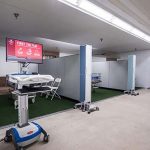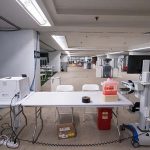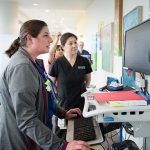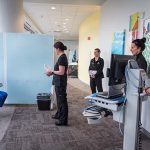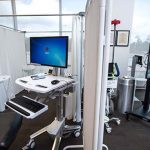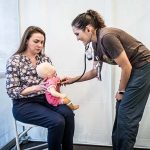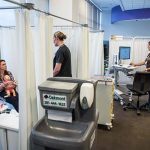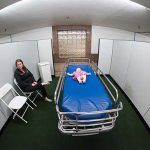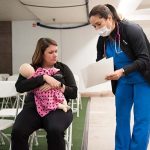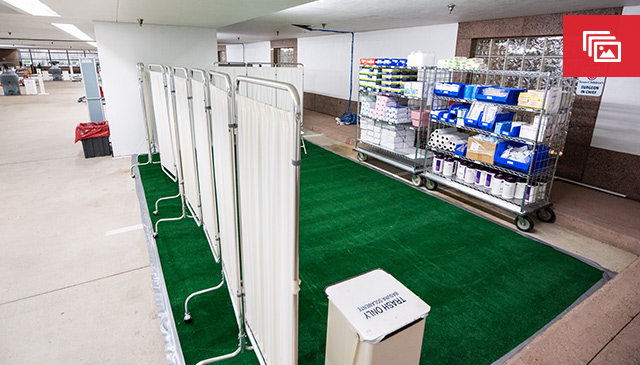
After Hurricane Katrina slammed into New Orleans in 2015, thousands of people poured into Houston looking for food, shelter and medical care. Many of them were housed at NRG Stadium, including children. Texas Children’s – one of the only pediatric medical institutions on site – set up shop inside the stadium and started caring for the children – more than 2,500 in all.
In 2009, Texas Children’s used a similar concept during the H1N1 pandemic setting up what we now call our Mobile Pediatric Emergency Response Team (MPERT) in the physician parking lot across from our Emergency Center in the Medical Center. Medical staff working MPERT saw about 60 children a day during that crisis, providing capacity for the surge of patients coming to our Emergency Center.
Several weeks ago when the COVID-19 pandemic hit the United States, leaders asked themselves whether they should launch MPERT again. Even though the disease’s target is not children, they decided to move forward with the effort not only at Texas Children’s Hospital in the Medical Center but at Texas Children’s Hospital West Campus, Texas Children’s Hospital The Woodlands and the Pavilion for Women.
“Texas Children’s has always had a keen eye to preparedness whether it be H1N1, Ebola or COVID-19,”said Medical Director of Emergency Management Dr. Brent Kaziny. “We have never faltered in our commitment to provide exceptional care in times of crisis including the one we are facing today with COVID-19.”
Teams across the Texas Children’s system, including Facilities, Information Services, Pharmacy and Emergency Services, have been working hard over the past few weeks to set up MPERT in the Medical Center, at West Campus and in The Woodlands. The teams are tailored to their locations. One is set up in a parking garage, the other in a clinic waiting room and another in a large, low-traffic hallway. If needed, Texas Children’s also has tents that can be set up in parking lots to handle additional overflow patients.
Each site includes intake, waiting, triage and clinical areas equipped to treat patients who do not have a significant medical history but are exhibiting upper respiratory symptoms. Members of the mobile teams can test patients for flu, strep, urinary tract infections and COVID-19.
The Mobile Maternal Emergency Response Team at the Pavilion for Women is set up in the ambulance dock area in the Medical Center. If a surge of patients occurs, the team will be ready to triage, test and even deliver babies, if necessary. The team is currently being used to test for COVID-19 expectant mothers who are scheduled for an induction.
“We have weathered many things at Texas Children’s and this crisis will be no different,” said Lynda Tyer-Viola, vice president of nursing at the Pavilion for Women. “Because of our resilience, we will come out of this stronger and better.”
Senior Vice President of Facility Operations Bert Gumeringer said his team situated the mobile teams so they can quickly and efficiently triage and treat as many patients as possible.
“This was a large undertaking but everyone worked together and got it done for the good of our patients, families and staff,” Gumeringer said. “Doing what is best for them and for our colleagues is and always has been our primary goal.”
Simulations have been held at all of the mobile sites, all of which will only be launched if there is a surge of patients coming into our system wanting to be tested for COVID-19 or are exhibiting symptoms of the disease. Until then, these teams will stand ready to serve.
“We are here and we are ready to take care of any and all patients who need us during this time,” said Ryan Breaux, director of business operations and support services at West Campus. “I’m extremely proud to work for an organization that is committed to disaster preparedness and to fulfilling our mission no matter the circumstance.”
Eric Allum, director of business operations and support services in The Woodlands, agreed and said Texas Children’s is recognized nationally when it comes to disaster preparedness and that the organization’s dedication to such efforts has paid off.
During Tropical Storm Allison, for example, Texas Children’s was able to stay open and continue to care for patients and families because leaders had the forethought to invest in flood doors in the hospital’s basement.
“We were the only operational hospital in the Medical Center that didn’t flood,” Allum said. “It’s a phenomenal commitment that the organization put forth then and has continued with each new challenge.”


